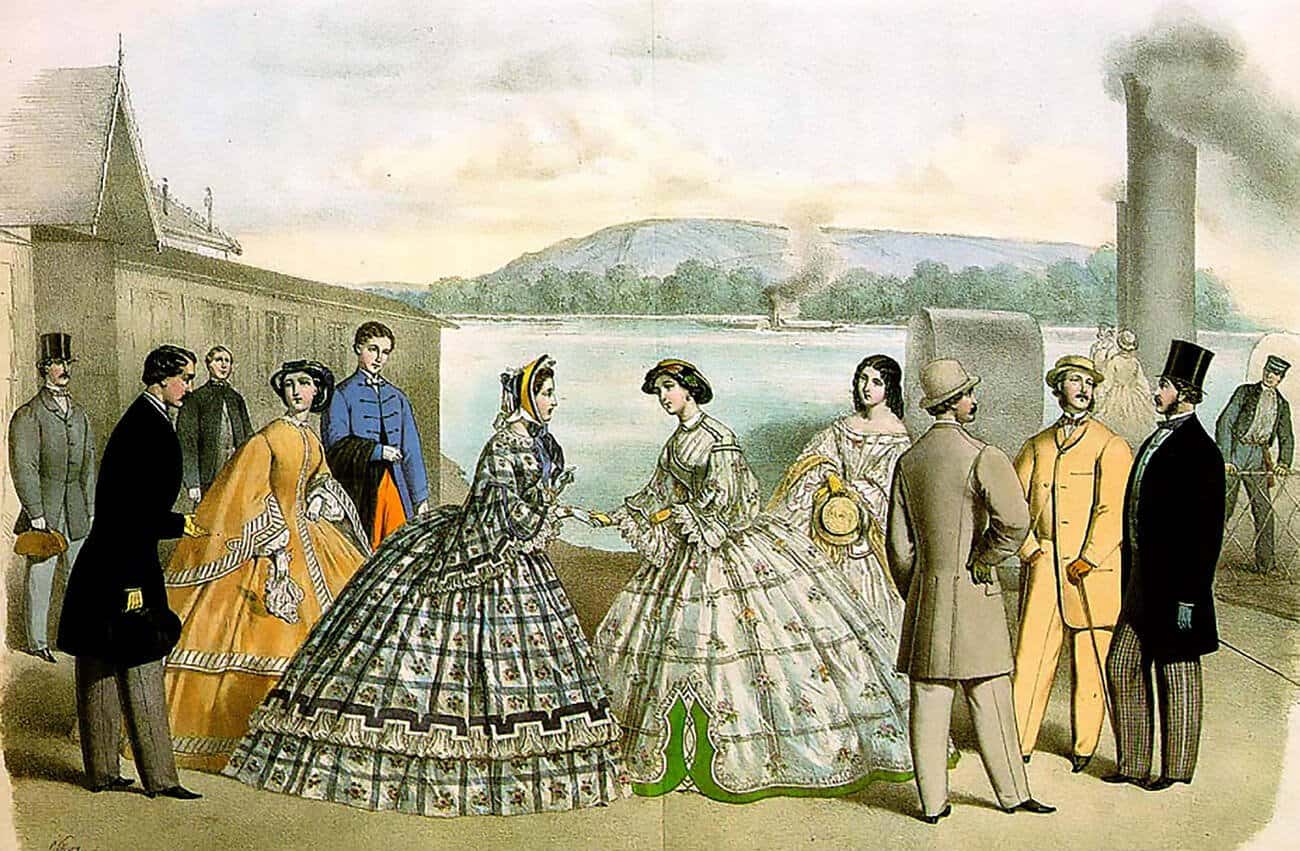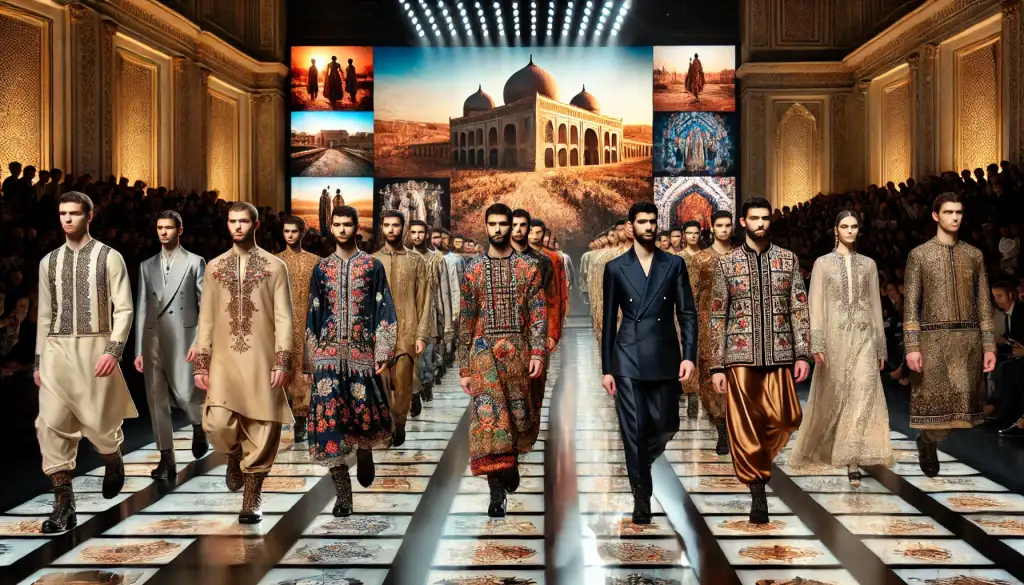Did you know that in the 19th century, fashion was all about opulence and tradition? Women’s clothing underwent significant changes during this time, with skirts evolving from tubular shapes to more angular silhouettes. Corsets and petticoats were worn for support, while the emergence of the cage crinoline allowed skirts to reach their largest circumference. Military-inspired fashion became popular, and evening wear showcased elegant styles. Join us as we explore the trends and influences that shaped 19th-century fashion.
The Evolution of Silhouettes
The silhouette of women’s fashion in the 1860s shifted from a dome-shaped silhouette in 1860 to a pyramid-shaped silhouette for most of the decade. This evolution of silhouettes showcased the opulence and tradition that defined fashion in the 19th century. During this time, Victorian era fashion was characterized by its focus on femininity and exaggerated shapes. The female silhouette in the 19th century featured fitted bodices, wide skirts, and high necklines for daytime wear. In the evening, dresses had dropped off-the-shoulder necklines trimmed with bertha collars or lace. The use of petticoats, ruffles, and bold colors added flair to skirts, while looped overskirts and long basques became fashionable later in the decade. Overall, the changing silhouettes reflected both societal norms and artistic expression of beauty during this era.
The Influence of the Cage Crinoline
Embrace the influence of the cage crinoline and experience the transformative effect it had on 19th-century women’s silhouette. In the opulent world of fashion, tradition was challenged as the cage crinoline took center stage in the 19th century. This innovative undergarment revolutionized women’s fashion by creating voluminous skirts that defied gravity and societal norms. The cage crinoline, consisting of concentric steel hoops attached with tape or braid, allowed skirts to reach their largest circumference around 1860. With its pyramid-shaped silhouette, this garment became a symbol of extravagance and femininity. Despite ridicule from skeptics, women embraced this new trend, as it provided them with freedom of movement and an opportunity to express their individuality through fashion. The cage crinoline remains an iconic symbol of innovation and style in the 19th century fashion landscape.
Daytime Fashion: Bodices and Sleeves
Experience the freedom and versatility of daytime fashion in the 1860s with bodices featuring various sleeve styles and high necklines. In this opulent era, tradition blended with innovation to create stunning looks that reflected the changing times. Here are five key elements of 19th-century daytime fashion:
- Bell-shaped pagoda sleeves: These wide, bell-shaped sleeves carried over from the previous decade and added a touch of elegance to any outfit.
- Jacket or coat sleeves: The most common sleeve style for daytime bodices resembled a man’s coat sleeve, giving women a sophisticated and tailored look.
- Detachable collars: To add versatility to their day dresses, women could easily change up their neckline by attaching different collars.
- Belted waistlines: Completing the day dress ensemble, belts were often worn at the waist to accentuate a woman’s figure.
- High necklines: Reflecting the modesty of Victorian society, high necklines were a staple in daytime fashion during this period.
Embrace these timeless elements of 19th-century fashion and add an air of opulence to your modern wardrobe.
The Rise of Shirtwaists and Military-Inspired Fashion
Get ready to explore the rise of shirtwaists and military-inspired fashion in the 1860s with their casual yet stylish combinations of skirts and blouses. In the opulence and tradition of fashion in the 19th century, French influence played a significant role in shaping mid-century styles. French 19th century fashion was known for setting le dernier cri, or the latest trend. During this time, there was a surge in popularity for shirtwaists, which were blouses worn with skirts. These shirtwaists provided a more comfortable and practical alternative to corsets and dresses. Additionally, military-inspired fashion became a prominent trend in mid-19th century fashion. Garibaldi shirtwaists, inspired by Italian freedom fighter Giuseppe Garibaldi, featured high necklines and full sleeves. The Zouave jacket, borrowed from Algerian Zouave troops, also gained popularity with its rounded borders trimmed in soutache braid. Explore these fascinating fashion trends in the 1800s to witness the fusion of opulence and tradition that defined this era.
Elegant Evening Wear
In the 1860s, women embraced more elegant and revealing styles for evening wear, with dropped off-the-shoulder necklines and trimmings like pleated silk or lace adding sophistication to their dresses. It was a time of opulence and tradition in fashion, where women sought to showcase their beauty through intricate details and luxurious fabrics. The elegance of the evening wear reflected the societal norms and expectations of the time, as women were expected to exude grace and refinement during formal occasions. The 19th century was a period when fashion played a significant role in expressing one’s status and taste, making elegant evening wear an essential part of a lady’s wardrobe. Through these sophisticated designs, women not only adhered to societal standards but also found ways to express their individual style within the confines of tradition.
Neoclassical Influence and the Impact of the Napoleonic Wars
Embrace the neoclassical influence and learn about the impact of the Napoleonic Wars on European fashion during this time period. The 19th century was a time of opulence and tradition in fashion, with French 19th century fashion leading the way. The neoclassical influence brought a return to classical antiquity, with garments inspired by Greek and Roman styles. However, the impact of the Napoleonic Wars cannot be overlooked. As war swept across Europe, it had a profound effect on fashion. Resources became scarce, leading to simpler designs and less extravagant embellishments. Practicality and functionality became more important as women’s clothing adapted to fit wartime conditions. Despite these challenges, French fashion continued to set trends, blending opulence with practicality in a way that defined 19th-century style.
Hairstyles, Headwear, and the Fashion Icon of the Era
Now that you have learned about the neoclassical influence and the impact of the Napoleonic Wars on 19th century fashion, let’s delve into another fascinating aspect of this era: hairstyles, headwear, and the fashion icon of the time.
During the 19th century, hairstyles were a prominent feature in women’s fashion. Hair was often styled with a center parting and adorned with ringlets in the front and curls at the back. Some women even opted for cropped hairstyles in the early 1810s.
As for headwear, various hats, caps, and bonnets were worn to complement different outfits. Poke bonnets and tall conical hats were particularly popular choices. Additionally, turbans remained stylishly fashionable during this period, influenced by Napoleon’s occupation of Egypt.
When it comes to fashion icons of the era, Empress Joséphine Bonaparte takes center stage. She was not only a major influencer but also a true fashion icon who adored fine muslins and luxurious Kashmiri shawls. Her love for Indian shawls played a significant role in establishing the high waistline as a trend during this time.
In summary:
- Hairstyles featured center partings with ringlets and curls.
- Various hats, caps, and bonnets were worn.
- Turbans remained stylish due to Napoleon’s occupation of Egypt.
- Empress Joséphine Bonaparte was a leading fashion icon.
- She favored fine muslins and Kashmiri shawls as signature pieces.
These aspects of hairstyles, headwear, and influential figures contributed to both opulence and tradition in 19th-century fashion.
Men’s Fashion: Trends and Influences
Explore the trends and influences that shaped men’s fashion during this era. In the opulent and traditional world of 19th century fashion, men’s style underwent significant changes influenced by various factors. The Napoleonic Wars played a crucial role in shaping men’s fashion, with military uniforms dominating public life. British tailors led the way with their expert fit and fine woolen cloth, creating a more understated and democratic look for men. The silhouette evolved with dropped waists and added shoulder padding after 1811. Coats featured turn-down collars, lapels with sharp M or V notches, while tall boots became popular choices for daytime wear. Pantaloons tucked into hessian boots were particularly fashionable. Through these trends and influences, men’s fashion in the 19th century showcased a blend of opulence, tradition, and practicality.
Children’s Fashion: From Infancy to Teenage Years
Transitioning from infancy to teenage years, your children’s fashion in the 1810s evolved with changes in dress styles and hemlines as they grew older. In a time characterized by opulence and tradition, the fashion of the 19th century influenced every aspect of clothing, including children’s attire. Here are five key elements that defined children’s fashion during this period:
- Chemises: These loose-fitting undergarments were worn next to the skin for comfort and hygiene.
- Drawers: Similar to modern-day underwear, drawers provided additional coverage and protection.
- Bustles and petticoats: These structures were used to create volume in skirts, giving them a fashionable silhouette.
- Corsets: While primarily worn by women, corsets were also used to shape young girls’ bodies and create a desirable figure.
- Bonnets: A staple in children’s fashion, bonnets provided sun protection while adding a touch of elegance.
Throughout their journey from infancy to teenage years, your children would have been dressed according to the prevailing trends of the time. Embracing both opulence and tradition, their attire would have reflected the distinctive style of 19th-century clothing.
Outerwear and Textiles of the 19th Century
When it comes to outerwear and textiles in the 19th century, you’ll find a variety of long coats like pelisse and redingote, as well as military-inspired trim such as braid, tassels, frogging, and cords. The opulence and tradition of fashion during this time period is evident in the intricate details and luxurious fabrics used in outerwear. To give you a sense of the styles that were popular, here is a table showcasing some examples:
| Outerwear | Trim | Description |
|---|---|---|
| Pelisse | Braid | A long coat with braided detailing |
| Redingote | Tassels | An elegant coat adorned with tassels |
| Military-Inspired | Frogging | Coats featuring decorative loops or knots |
| Cords | Jackets embellished with twisted cords |
This combination of opulent fabrics and traditional trimmings created an air of sophistication in 19th-century outerwear. It was a reflection of the fashion trends of the time, where elegance and attention to detail were highly valued.
Read these next:
What Shoes To Wear With Pink Outfit For Women
Mastering Denim and Boots: Do Jeans Go Over Or Under Ankle Boots?


